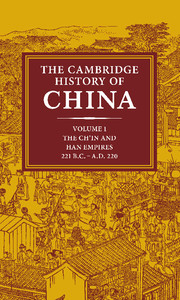Book contents
- Frontmatter
- Introduction
- 1 The state and empire of Ch'in
- 2 The Former Han dynasty
- 3 Wang Mang, the restoration of the Han dynasty, and Later Han
- 4 The conduct of government and the issues at stake A.D. 57–167
- 5 The fall of Han
- 6 Han foreign relations
- 7 The structure and practice of government
- 8 The institutions of Later Han
- 9 Ch'in and Han law
- 10 The economic and social history of Former Han
- 11 The economic and social history of Later Han
- 12 The religious and intellectual background
- 13 The concept of sovereignty
- 14 The development of the Confucian schools
- 15 Confucian, Legalist, and Taoist thought in Later Han
- 16 Philosophy and religion from Han to Sui
- Bibliography
- Glossary-Index
- Map 7 The Han empire, 143 b.c.
- Map 8 The Han empire, 108 b.c
- Map 9 The Han empire, a.d. 2
- Map 12 The Han empire, a.d. 140">
Introduction
Published online by Cambridge University Press: 28 March 2008
- Frontmatter
- Introduction
- 1 The state and empire of Ch'in
- 2 The Former Han dynasty
- 3 Wang Mang, the restoration of the Han dynasty, and Later Han
- 4 The conduct of government and the issues at stake A.D. 57–167
- 5 The fall of Han
- 6 Han foreign relations
- 7 The structure and practice of government
- 8 The institutions of Later Han
- 9 Ch'in and Han law
- 10 The economic and social history of Former Han
- 11 The economic and social history of Later Han
- 12 The religious and intellectual background
- 13 The concept of sovereignty
- 14 The development of the Confucian schools
- 15 Confucian, Legalist, and Taoist thought in Later Han
- 16 Philosophy and religion from Han to Sui
- Bibliography
- Glossary-Index
- Map 7 The Han empire, 143 b.c.
- Map 8 The Han empire, 108 b.c
- Map 9 The Han empire, a.d. 2
- Map 12 The Han empire, a.d. 140">
Summary
This volume gives an account of the first of the Chinese united empires, known respectively as the Ch'in, Former Han, Hsin, and Later Han dynasties. (The terms Western and Eastern Han sometimes appear in place of Former and Later Han.) The obvious dates marking the beginning and the end of the period are those of two key events: the establishment of the Ch'in empire in 221 B.C. and the abdication of the last Han emperor in A.D. 220. However, these two specified years should not be taken as the rigid limits of the period that is covered by this volume. The events of 221 B.C. were the culmination of developments of the preceding centuries, and of necessity the first chapter of the book refers readers to the incidents, personalities, and developments of the Warring States period. Similarly, although the abdication of Hsien-ti may be regarded as the formal end of the Han dynasty, the process of imperial disruption was already far advanced long before that date; it may even be maintained that in real terms the outbreak of the revolt of the Yellow Turbans, in A.D. 184, marked the end of Han imperial authority. In considering the political developments of these last decades, when a powerless emperor still occupied the Han throne, it is essential to look forward to the succeeding period, when the disruption of the Han empire had finally taken place and its territories split between the three coexistent kingdoms of Wei, Shu-Han, and Wu.
- Type
- Chapter
- Information
- The Cambridge History of China , pp. 1 - 19Publisher: Cambridge University PressPrint publication year: 1986
- 2
- Cited by

